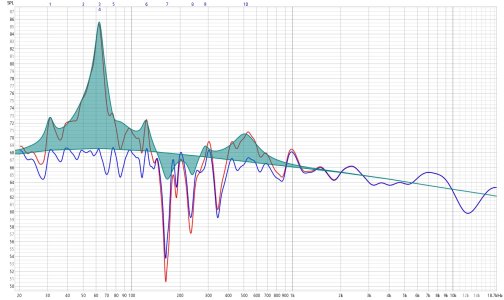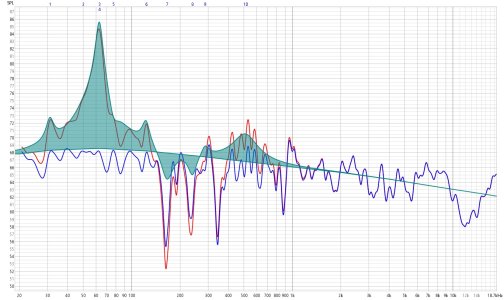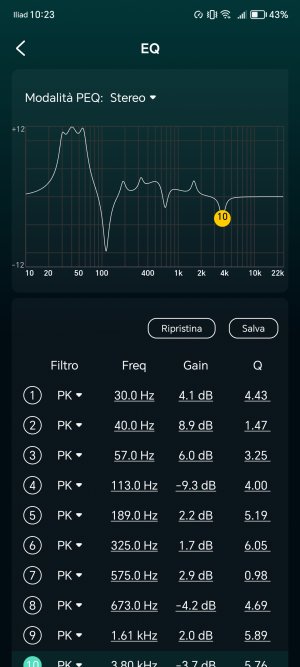slartibartfast
Major Contributor
- Joined
- Apr 18, 2024
- Messages
- 5,113
It's doing something odd. I'll try some different values if I get a chance.Is WHA confusing twenty with twelve?
It's doing something odd. I'll try some different values if I get a chance.Is WHA confusing twenty with twelve?
How do you know what effect the converter cable has on the frequency response? You might be lucky but one I bought rolled off at low frequencies.I’ve realised that i bought and have been using the iMM-6 with converter cables a few months ago based on a comment i’d seen a a forum discussing housecurve. Is the 6c the better choice for room calibration? I’m using it with the calibration file so it should be corrected
we don't know what is behind the rc mode...maybe just max limits set in the algorithm...How do you know what effect the converter cable has on the frequency response? You might be lucky but one I bought rolled off at low frequencies.
By the way you quoted the wrong postwe don't know what is behind the rc mode...maybe just max limits set in the algorithm...
you should perform this same test more in the high frequencies and more reasonable values than this 20db
addressing you I just took your last message knowing that you would understand...By the way you quoted the wrong post. I'll try a few different values at different frequencies.
Yeah, the maximum gain of RC is 12.5 dB, so the calibration limit of 12 dB is predictablewe don't know what is behind the rc mode...maybe just max limits set in the algorithm...
you should perform this same test more in the high frequencies and more reasonable values than this 20db
Good point, I'll try 10dBYeah, the maximum gain of RC is 12.5 dB, so the calibration limit of 12 dB is predictable
Can you post a screenshot of the response measured by WiiM room correction? What was the frequency range for room correction? I would like to try acoustic panels but I think they would be even more trial and error for meAfter many trials and error attempts, I have decided to wait for room correction to include L/R correction + sub before I give it another go. With the current stereo room correction with sub I cannot seem to get a better sound than without it. I try to listen with RC on for a while, but always come to the conclusion that it sounds better without it. I highly doubt that my room is perfect as is, and I would think that even the best rooms could be enhanced by just the right rc. So far I am getting way beter results with sound absorbing panels and no correction. When I say results, I am referring to better sound in my ears - no measurements.
Perfect test.OK I changed the calibration up to 90Hz to -10dB and the same for 4kHz to 8kHz. Everything else set to 0dB. Now the results make sense and the step looks like 10dB
View attachment 17411
View attachment 17412
Going back to the REW vs WiiM comparison I added the WiiM filter values to the REW measurement graph and the low frequencies definitely do not follow the B&K target curve. You can see the blue line is completely below the target at frequencies below around 150Hz. The first graph uses VAR smoothing and the second uses 1/12th octave smoothing.I compared a room correction from WiiM with one from REW using the B&K target. Blue is REW, Red is WiiM. You can see the WiiM RC has filled the dips slightly but only by 2-3dB. The low frequencies are noticeably lower in the WiiM curve indicating that balance between low and high frequencies isn't quite right. I used a range of 20-700Hz. Not bad though.
View attachment 17353


That’s why i was asking if it’s worth buying the c version. I would still need an adapter to go from usb to lightningHow do you know what effect the converter cable has on the frequency response? You might be lucky but one I bought rolled off at low frequencies.
Some users have reported good results with the iMM6 connected via a Google 3.5mm to USB adaptor but the only way to know for sure is to compare results against a USB mic.That’s why i was asking if it’s worth buying the c version. I would still need an adapter to go from usb to lightning
Hi Harkpabst,I just tried the calibration file import for my UMIK-2 (because it actually needs more correction than my UMIK-1). No comparison, no details so far. But the result was the most reasonable looking with my WiiM Amp Pro.
No crazy low Q boost anymore, so cal file.import turns out to address two topics in one go. Now I need just more time to play around with this.
While WHA 3.1.3 brought this long awaited feature it took away the balance slider for me.
Strange that the issue doesn't affect everyone then. I still have the balance control.Hi Harkpabst,
This is a known issue with the latest Android app. We will release an updated version to address it and restore the Volume Balance feature.
Yes, it's really weird. I still have the slider tooStrange that the issue doesn't affect everyone then. I still have the balance control.
